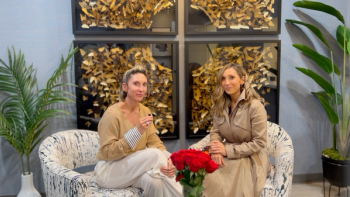
Urologists' environmental footprint: a closer look
"There is no planet B and, collectively, small individual actions can make a big difference," says Stacy Loeb, MD, PhD, MSc.
The state of the environment is connected to everything, including urology, and there have been an increasing number of studies examining this relationship.
Stacy Loeb, MD, PhD, MSc, is one urologist who has expressed interest and even led studies concerning the urologic impact on the environment. In a recent interview, she discusses a relevant study presented at the 2021 American Urological Association (AUA) Annual Meeting1 that assesses the difference in climate impact since urology meetings went virtual, as well as the correlations between urologic conditions, urologic practices, and sustainability. Loeb is a professor in the departments of urology and population health at the NYU Grossman School of Medicine, New York City, New York.
What are some associations between urologic conditions and the environment?
Well, really all human health is inextricably linked with environmental health. The quality of the air we breathe, for one, not only has a great impact on respiratory health, but also cardiovascular health and renal health. In the field of urology, these things can also make a difference. For example, there are studies projecting a significant increase in the amount of kidney stones in the future due to climate change, because warmer temperatures mean more kidney stones. So, this is going to have wide ripple effects all throughout health care.
What can urologists do to reduce their environmental footprint?
I think there's a lot we can do in all parts of the job. One thing that we've been studying recently is the environmental impact of travel for urology conferences. We had a publication reporting on how many carbon emissions were saved from the AUA and [European Association of Urology] meetings going virtual for a year, and that was only considering travel-related emissions, which is just 1 piece of the puzzle. Even so, it was about 15,000 and 11,000 metric tons of carbon dioxide that were saved. This is a huge amount – the equivalent of more than 5800 passenger vehicles driven for a year. More recently, we have a paper that's in press at the Journal of Urology, that looks at the environmental footprint of travel for residency interviews in urology. And again, we showed quite a significant impact in terms of carbon emissions as well as cost. So, there's definitely some real important reasons why having virtual meetings or offering hybrid options could be great for participants in terms of reducing the burden associated with travel as well as the cost and the environmental footprint.
Beyond that, if you're hosting conferences, there are a lot of recommendations published online in terms of how to have greener conferences. For example, not having a lot of printed materials or even the catering services are very important. And this would apply to conferences as well as hospitals, and more generally, the food has a significant environmental footprint. Plant-based foods are more environmentally sustainable, so having more of those options at meetings is great.
The good news is that plant-based diets are also better for overall health. We just had a big press conference at the AUA meeting with several studies suggesting plant-based diets were associated with the lower risk of erectile dysfunction, lower risk of elevated PSA, and a lower risk of aggressive prostate cancer. So, that’s good news. What's good for the planet also appears to be good for a lot of the highest burden urology conditions we see. I think it's so interesting how all of this ties together. For example, we know that intake of meat is not only associated with prostate cancer and erectile dysfunction, but also increases the risk of kidney stones. Meanwhile, meat is one of the heaviest foods in terms of burden to the environment. So, really, eating meat is increasing risk of kidney stones at the individual level, but also at a societal level because the more that climate change occurs, the higher kidney stone prevalence occurs.
Bottom line, there's really no way to separate all of the things that we do, but I think we can all be more conscious on a day-to-day basis in terms of our own environmental footprint and just making better choices. If you're at an in-person meeting, you can stay at a hotel that's closer to the conference, and that has less emissions. You can use public transportation or take the key out of the hotel room slot so that the lights and the energy are not being used while you're out of the hotel room all day. In our daily lives, there's so much that we can do and the same thing applies at work. Being conscious of using various things in the operating room, not opening the packages up until you've determined what is needed for the case so that there's not a lot of extra wasted materials. And a lot of people have been doing some initiatives on this, trying to reduce operating room waste and other kinds of waste, reducing the amount of printed materials at urology conferences, converting things to virtual. I think that was definitely precipitated a lot by the pandemic, but now as everybody has gotten more comfortable with these mechanisms, hopefully in the future there will be many more virtual options.
And, of course, telemedicine. There's been some really interesting studies in the literature about the environmental footprint of clinic visits. Here in New York City, somebody might be in the car for 2 hours trying to come see me the way things are here, so being able to meet through telemedicine is a lot more convenient for both of us and saves on all that that transportation. I think telemedicine is another great trend that can help.
You were senior author of a paper presented at the 2021 AUA annual meeting regarding the climate change impact of virtual urology meetings. Could you describe some of this study’s key findings?
What we did is we determined where all the participants came from to the AUA and EAU meetings and use that information to estimate the number of carbon emissions associated with travel to the conferences and from the conferences, from those respective locations. So, these are really just estimations since we don't know necessarily how people got there. We did make some assumptions about whether you would drive or potentially take a train or a plane, but this is just for a hypothetical experiment to show the type of scale that we're talking about here. A savings of 15,000 or 11,000 metric tons of carbon dioxide is a lot. That's more than 5600 passenger vehicles driven for a year and that's the same emissions from 3 million gallons of gasoline. So, it's quite a significant burden, and that only accounts for travel-related emissions from participants.
We did not account for vendors at the exhibition hall, staff who are working on the conference, or the many other factors related to the conference—printed conference materials, transportation to and from the hotel to the meeting facility, energy that's used in the convention center, and food-related emissions from the catering services. Really, these are underestimates, if anything, of the true burden that having an in-person meeting really has for the environment. On the flip side, there are some studies showing that fewer people would be interested in submitting an abstract to a virtual meeting. And certainly, we all miss the camaraderie of seeing each other in person. So, that's not to say that in-person meetings don't have some advantages and a place, but it is an interesting consideration.
Is there anything else you feel our audience should know about this topic?
I think we're only at the beginning of looking into this and learning about this, so I would encourage other people to think about their own routines in the operating room, in the clinic, going to conferences, hosting conferences, doing interviews, and where each one of us could even slightly cut back because we really do need to take dramatic action for climate change. There is no planet B and, collectively, small individual actions could make a big difference.
Reference
1. Patel S, Gallo K, Becker R, Loeb S. Climate change impact of virtual urology meetings. Paper presented at: 2021 American Urological Association Annual Meeting; September 10-13, 2021; virtual. Abstract PD02-12.
Newsletter
Stay current with the latest urology news and practice-changing insights — sign up now for the essential updates every urologist needs.


















